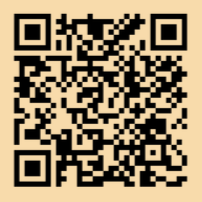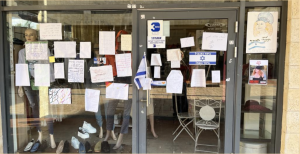What to do when we can’t do it alone?
Prep for the Session
Overview
This resource engages with the Israel-Hamas war through the value of Solidarity.
At-a-Glance:
This resource was created by the Values in Action team, in response to the horrific terror attacks on Israel by Hamas. It is designed by educators for educators as a tool for processing the events of the moment through a values-based approach. It does not engage with politics, history or religion per se, but rather offers a path for educators to help their learners and community members process the moment we are in, with values as a starting point.


- Posterboard and markers, post-its, or a shared document (Google doc,
Jamboard etc.)

- For tweens and teens
- For a way to express personal solidarity in a moment of need
Let’s Get Started
OPENING PROMPT

MERAV’S STOREFRONT:
Facilitator reads for framing:
On October 7th, Merav, her partner Yaya, and Yaya’s two sons were taken hostage by Hamas terrorists.
|
Scan the QR Code or click here to read Merav’s story. Merav was the proud owner of a clothing store in Gedera. Now, the storefront is covered with heartfelt messages that read, “Merav, come home” and “The Ginger of Gedera, Merav, is Kidnapped.” |
 |
Below is a photo of Merav’s storefront.


Facilitator prompts the group:
• Merav, unfortunately, cannot see these letters. So why were they written, and who do you think they were intended for?
EXPLORE THE VALUE

Facilitator reads:
These letters serve as a powerful demonstration of solidarity, even though they may not directly impact the situation. Nevertheless, they are a heartfelt gesture of support.
Solidarity is commonly defined as “unity or agreement of feeling or action.” Notice the end of that definition – solidarity is not only a feeling, it also implies a behavior, and action.
But who is that behavior ultimately for?

Let’s consider the storefront letters and respond to 2-3 of the following prompts:
- In what way does writing a letter to Merav, as an act of solidarity, help the person writing the letter?
- In what way does writing the letter help Merav’s community?
- In what way does writing the letter help the Jewish people?
- Might writing the letter help Merav and the other hostages? If so – how
JEWISH ANCHOR

Read the following text from the Talmud in pairs and discuss the prompts below:
Extending A Hand: Talmud tractate Brachot 5b
The Talmud recounts a story where a student of R. Yohanan fell ill, and R. Yohanan took his hand and was able to raise/heal him. The Talmud then continues and tells us about a time that R. Yohanan himself fell ill.
|
Rabbi Yoḥanan fell ill. |
|
|
Rabbi Ḥanina entered to visit him, |
|
|
and said to him: Is your suffering dear to you? |
|
Rabbi Yoḥanan said to him: I welcome neither this suffering nor its reward. |
 |
|
Rabbi Ḥanina said to him: Give me your hand. He gave him his hand, and Rabbi Ḥanina stood |
 |
|
him up and restored him to health. |
 |
|
The Talmud asks: Why did Rabbi Yoḥanan wait for Rabbi Ḥanina to restore him to health? If he was able to heal his student, let Rabbi Yoḥanan stand himself up. |
|
The Talmud answers, they say: A prisoner cannot free himself from prison, but depends on others to release him from his shackles. |
 |

Facilitator prompts the group:
- Re-state the key component of the narrative in your own words.
- What is the question that the Talmud is answering?
- Consider the closing line – “A prisoner cannot free himself from prison, but depends on others to release him from his shackles.” Discuss how reading this line from a text written so long ago, makes you feel today.
Facilitator continues reading:
Physically, emotionally, and spiritually, prisoners cannot liberate themselves from the confines of their captivity. They require the compassionate reach of others to extend a hand and facilitate their release. We may not have the physical means to free Merav and the other hostages, relying instead on the capabilities of our armed forces. However, through acts of solidarity, we can still extend our hands and contribute to our collective healing as a community and as a people.
ACTIVITY

A WALL OF SOLIDARITY:
Facilitator prompts the group:
Using posterboard (if in person) or a shared document (Google doc, Jamboard etc) and imagining it is Merav’s storefront, participants are invited to write a short note of solidarity
to Merav.
- Spend 2-3 minutes writing letters/notes.
- Participants are encouraged to read their letters out loud, and consider:
- If Merav, her family or friends, were to see this wall, what emotions might they stir within them?
- Reading the notes that have been shared, what emotions are stirred in you?
- Share with the group.

Prompt action

Facilitator prompts the group:
As you think about solidarity as something that is active, respond to the prompts below:
- What other avenues exist for extending your hand in acts of solidarity, and how might these actions contribute to the citizens of Israel and Jews around the globe?
- What is one step you can take in the coming days that increases your own personal sense of solidarity with the citizens of Israel?Share with the group.

Close with intention

Facilitator prompts the group:
- Expressing acts of solidarity can yield responses that are both outwardly focused, impacting others, and internally focused, changing ourselves. In what ways do you feel both?







 Back to What to do when we can’t do it alone?
Back to What to do when we can’t do it alone?